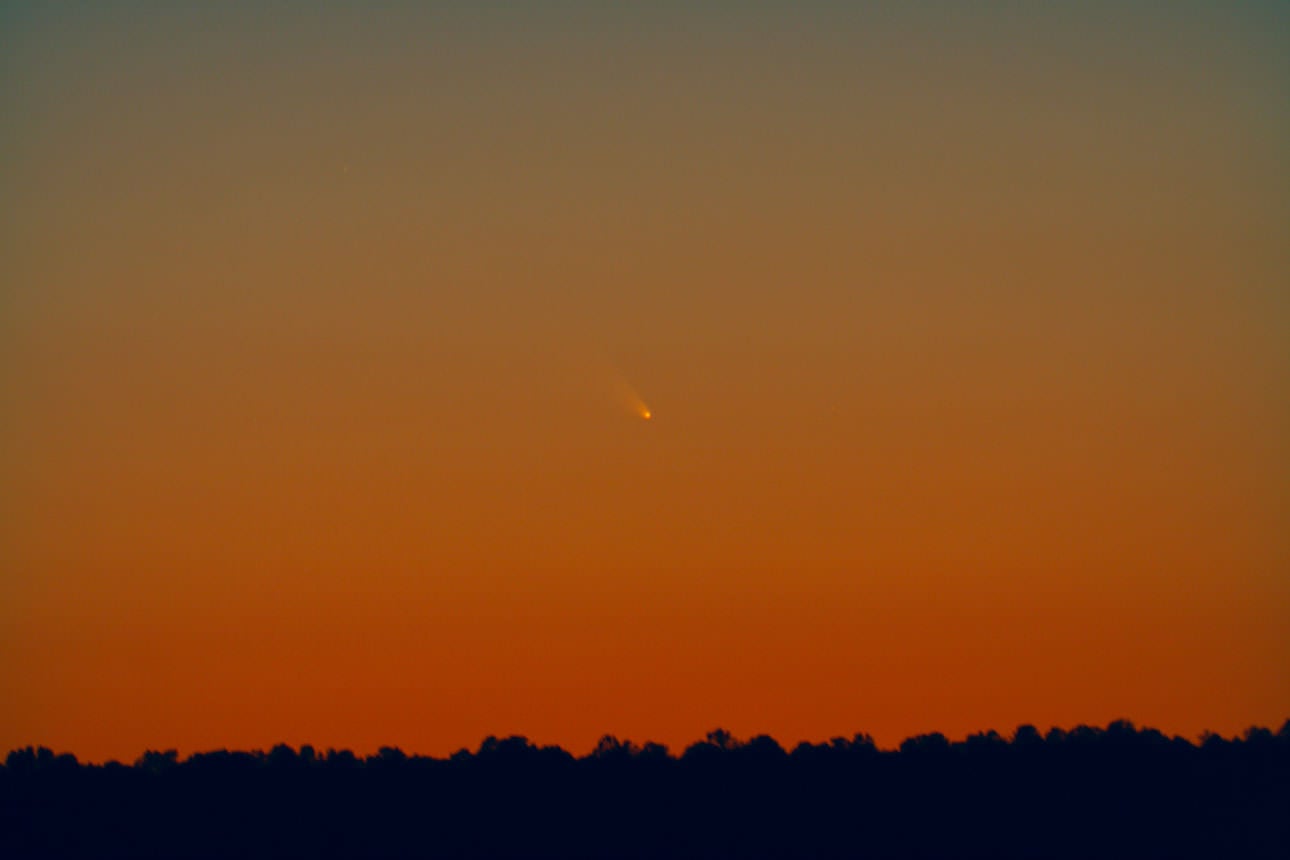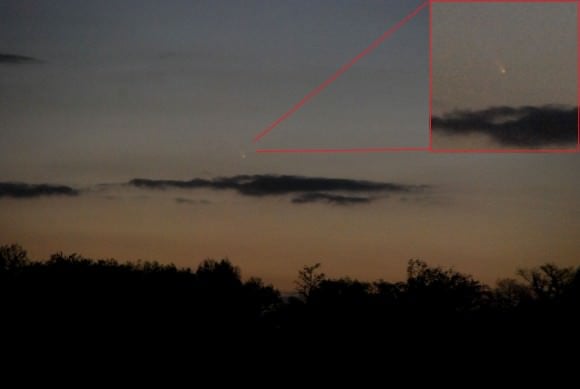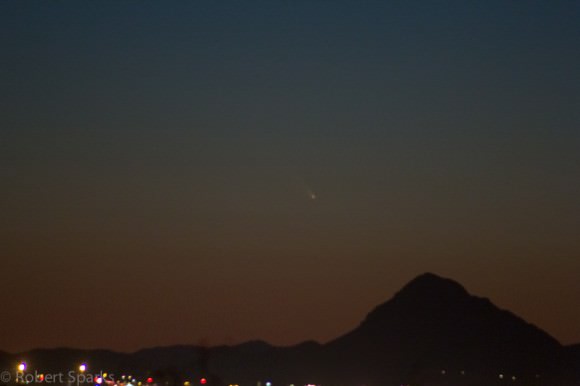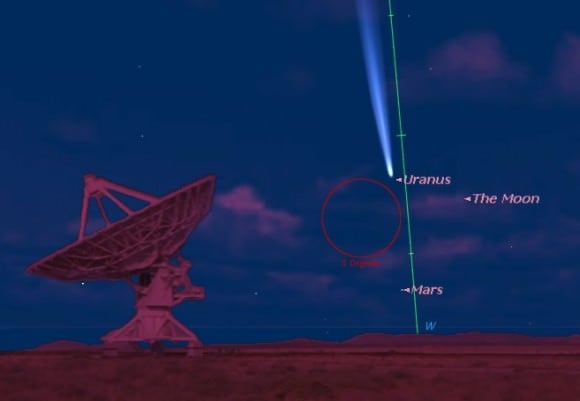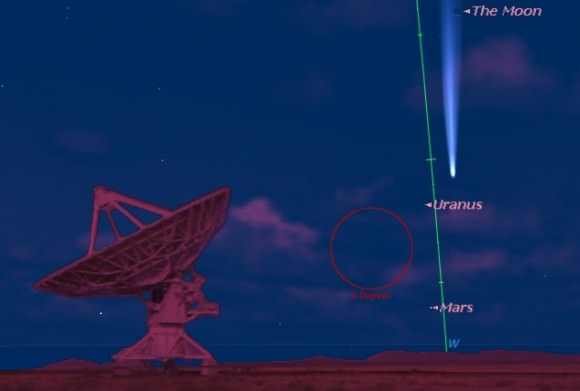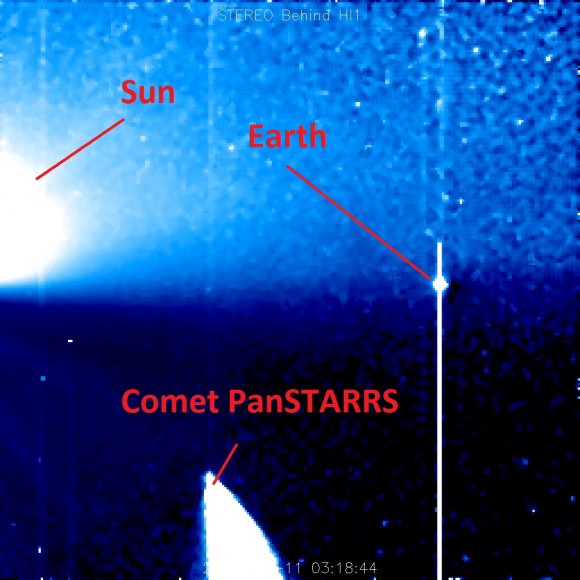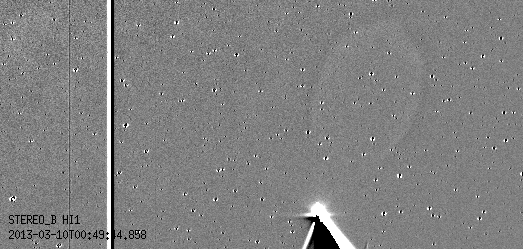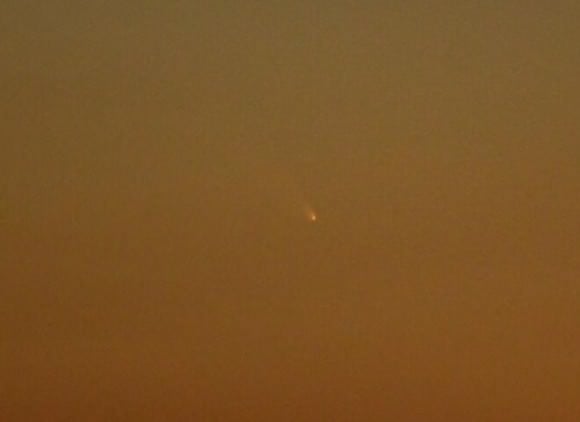The first of three bright comets anticipated in
2013
became visible to North American observers this past weekend.
Comet C/2011 L4 PanSTARRS
is now currently visible low to the southwest at dusk, if you know
exactly
where to look for it.
Observers in the southern hemisphere have been enjoying this comet for the past few weeks as it reached naked eye visibility above 6
th
magnitude around late February and began its long trek northward.
Comet PanSTARRS
is on a 106,000+ year orbit with a high inclination of 84.2° with respect to the ecliptic. This also means that PanSTARRS is
currently moving
roughly parallel to the "0 Hour" line in Right Ascension (The same point occupied by the Sun during next week's Vernal Equinox on March 20
th
) and is only slowly gaining elevation on successive evenings.
CometPANSTARRS from
Michael Zeiler
on
Vimeo
.
Observers in Hawaii and Mexico picked up PanSTARRS late last week, and scattered reports of sightings from the southern continental United States started trickling in Saturday night on the evening of March 9
th
. We managed to grab Comet PanSTARRS low to the southwest on Sunday evening on March 10
th
, about 30 minutes after local sunset.
[caption id="attachment_100624" align="alignnone" width="580"]
Comet PanSTARRS seen from Hudson Florida on the evening of March 10th (Photo by Author).[/caption]
We were surprised by the star-like appearance of the coma, about +1
st
to 2
nd
magnitude with a tiny fan-shaped tail. The comet was visible in binoculars only (I used our trusty pair of Canon 15x45 Image-Stabilized binocs for the task) and I couldn't yet pick out the comet with the naked eye.
Several sightings westward followed. Clay Davis based in Santa Fe, New Mexico noted a visual magnitude of -0.5, saying that PanSTARRS was "Brighter than Mars" at magnitude +1 but "A challenge to keep in view." Note that observer estimations of the brightness of comets can vary based on local sky conditions. Also, unlike a pinpoint star, the brightness of comets extends over its visible surface area, much like a faint nebula. The first sightings of the comet for many observers has been contingent on the weather, which can trend towards overcast for much of North America in early March. From our +28.5° northern latitude vantage point here just north of Tampa Bay Florida we had about a 10 minute window from when the sky was dark enough to spy PanSTARRS before it set below the local horizon.
Here are a few more images from Universe Today readers:
[caption id="attachment_100629" align="alignnone" width="580"]
Comet PanSTARRS as imaged by Robert Sparks (
@HalfAstro
) on the night of March 10th from Tucson, Arizona. All Rights Reserved, part of the Universe Today
photo gallery
.[/caption]
[caption id="attachment_100633" align="aligncenter" width="580"]
First views of Comet PANSSTARRS from Tucson, Arizona. Credit and copyright: Adam Block/Mount Lemmon SkyCenter.[/caption]
[caption id="attachment_100634" align="aligncenter" width="580"]
Comet PANSTARRS from Puerto Rico on March 10, 2013. Credit and copyright: Efrain Morales.[/caption]
To see the comet we suggest;
- A clear uncluttered southwestern horizon;
- A reasonably clear sky;
- Binoculars.
First naked eye sightings of the comet for U.S. and European latitudes should be forthcoming over the next few evenings. PanSTARRS just passed perihelion yesterday on March 10
th
at 0.3 Astronomical Units from the Sun (or 46.5 million kilometres, just inside the orbit of Mercury).
[caption id="attachment_100625" align="alignnone" width="580"]
Comet PanSTARRS looking west at 8PM EDT the evening of March 12th from latitude 30 degrees north. (Created by the author using Starry Night).[/caption]
And Comet PanSTARRS may put on its best show over the next few nights. The Moon reaches New phase today at 3:51PM EDT/ 19:51 UT and starts lunation number 1116. On the next few evenings, the slim crescent Moon will slide by Comet PanSTARRS. Look for the 2% illuminated Moon 5° to the lower right of the comet on the evening of Tuesday March 12
th
. On the next evening, the 5% illuminated Moon will be 9° above Comet PanSTARRS on Wednesday, March 13
th
. The age of the Moon will be 28 hours old on Tuesday evening and 52 hours on Wednesday the 13
th
respectively, an easy catch. The
Moonwatch website
is a great place to check for those early lunar crescent sighting possibilities worldwide. Note that Comet PanSTARRS also passes less than 30' from the planet Uranus (about the diameter of the Full Moon) on the evening of the 12
th
at 8 PM EDT/24UT. +6
th
magnitude Uranus may
just
be visible near the head of the comet using binoculars or a small telescope. Keep in mind, they just
appear
to be close as seen from our Earthly vantage point. PanSTARRS is currently 1.1 A.U.s from the Earth, while Uranus is on the other side of the solar system at 21 A.U.s distant!
[caption id="attachment_100626" align="alignnone" width="580"]
Comet PanSTARRS looking west at 8PM EDT from latitude 30 degrees north on the evening of March 13th. (Created by the author using Starry Night).[/caption]
PanSTARRS also crosses the Celestial Equator today on March 11
th
and the Ecliptic on March 13
th
. Observers from dark sky sites may get the added bonus of the
zodiacal light
, a true photographic opportunity!
Spacecraft studying the Sun are also giving us views of Comet PanSTARRS from a different perspective. NASA's twin
STEREO A & B
spacecraft are positioned to monitor the Sun from different vantage points along the Earth's orbit. Often, they see comets as an added bonus. Comet PanSTARRS has just moved into the field of view of STEREO-B's Heliospheric Imager and has given us
amazing views
of the comet and the Earth in the distance over the past week.
[caption id="attachment_100627" align="alignnone" width="580"]
The view of Comet PanSTARRS from NASA's STEREO Behind observatory. (Credit:
NASA/SECCHI
).[/caption]
From STEREO, the remarkable fan-shaped dust tail of PanSTARRS stands out in profile. The dust tail of a comet always points
away
from the Sun. Driven by the solar wind, a comet's tail is actually
in front
of it as it heads back out of the solar system! An ultimate animation of Comet PanSTARRS just came to our attention today via
@SungrazerComets
on Twitter;
[caption id="attachment_100636" align="alignnone" width="523"]
Animation of comet 2011 L4 PanSTARRS entering
STEREO-B's HI camera
, note the twin ion/dust tail reminiscent of Hale-Bopp! (Credit: NASA/STEREO/NRL).[/caption]
As of this writing, PanSTARRS seems to be performing as per predictions with an observed magnitude of around +1. The comet will continue on its northward trek, becoming a circumpolar object for observers based around latitude 50° north on April 2nd. Comet PanSTARRS should dip back below +6
th
magnitude around April 15th.
[caption id="attachment_100628" align="alignnone" width="580"]
Comet PanSTARRS as
imaged
by Mike Weasner from Cassiopeia Observatory in southern Arizona on the night of March 10th. Used with permission.[/caption]
But this is but Act One in a forecasted
three act cometary saga
for 2013.
Comet C/2012 F6 Lemmon
will grace early dawn skies in April for northern hemisphere observers, and then all eyes will be on
Comet C/2012 S1 ISON
for the hoped for grand finale later this year. Interestingly, ESA's Solar Heliospheric Observatory will get a look at this
sungrazing comet
as it passes through its LASCO C3 camera's field of view. Clear skies, and may 2013 go down as the Year of the Comet!
-Check out photos of Comet PanSTARRS and more being added daily to the Universe Today's
Flickr gallery
.
 Universe Today
Universe Today
